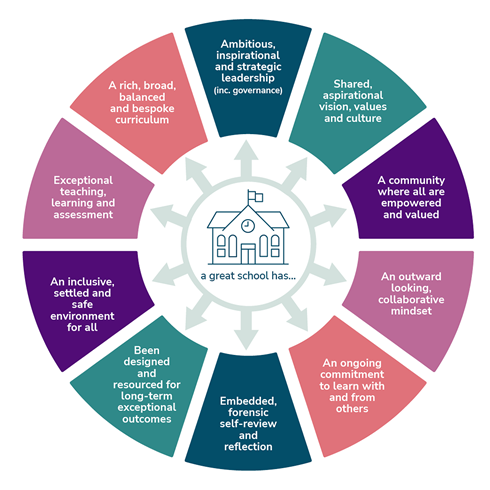A key motivator for constructing a Great School Framework (GSF) is to create a common language and understanding of all the component parts of a truly great school that can be shared by the education community, whatever their role and whatever their personal expertise or background. The GSF is a balanced model that looks at the whole school structure, rather than through a single lens or role.
We believe that creating a timeless, common sense of what greatness looks like will enable us to work more smartly together, striving to attain collective goals, through plans, contracts and services all focused on the same priorities.
The Great School Framework is undeniably and unapologetically ambitious, aspirational and visionary. It describes the constituent parts of a great school but recognises that there is a continuum across the lenses and that improvement can always be made as we strive to deliver the very best for the children and young people in our care. In fact we suspect that there is no such thing as a universally ‘Great School’, and that if any school thought that it was great in every aspect it would already be on a downward trajectory and lacking in honest and critical reflection. But what a wonderfully exciting journey to embark on to aim to get as near to the summit as possible, in the knowledge that every step taken towards greatness in each of the 10 features will improve the quality of education and the outcomes for pupils along the way.
So another key aim of the Great School Framework was to inspire schools and trusts (who are, after all, collectives of great and improving schools) to strive for constant improvement.
The language of the Great School Framework has been chosen carefully. It is significant that the adjective ‘great’ is not in the mainstream Ofsted vocabulary. Ofsted visits are able to provide a timebound measure of a school, based on the current framework and a snapshot in time.
Our vision of a great school goes well beyond an Ofsted “outstanding” descriptor and the features of the framework cover aspects of provision that Ofsted does not measure. We have striven to create a framework that would be as relevant to schools and settings 20 years ago as it is today and will be in the next 20 years. If a school was excelling in the Great School Framework, then they would succeed in any of the Ofsted frameworks. The GSF grounds us back into what research shows us makes a great school, rather than seeking the short-term goal of achieving well in the whatever is currently in the Ofsted framework.
The aim is that it is classic and timeless. The 10 lenses are non-sequential and non-hierarchical; there are, however, links between them.
At HFL Education, a key aim of the Great School Framework is to help ensure that all colleagues - from a data manager, to a governor trainer, to an Early Years adviser, to an administrator in the training and events team - understand the role they play in helping schools on their journey towards greatness, and can see where their work supports the 10 features of the framework.
At HFL, we provide support and services to support progression in the GSF. If it is all and everything we do.

The Great School Framework is the intellectual property of HFL Education and copyrighted. It may not be used unacknowledged by others.

